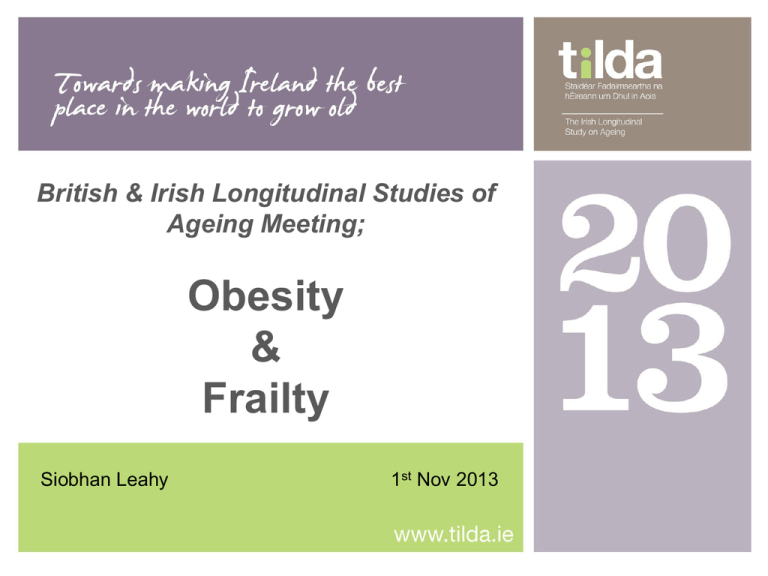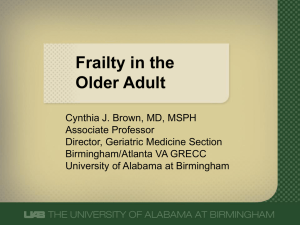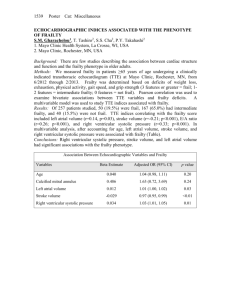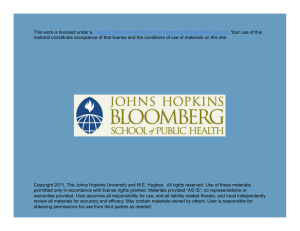
British & Irish Longitudinal Studies of
Ageing Meeting;
Obesity
&
Frailty
Siobhan Leahy
1st Nov 2013
Background
•Cross-sectional association between obesity and frailty identified in
ELSA and other studies (Blaum et al 2005; Hubbard et al 2010)
•Midlife obesity associated with later-life pre-frailty & frailty after 26y
follow up in men (Strandberg et al 2012)
•Waist circumference more strongly associated with frailty than body
mass index
Common factors implicated in Obesity and Frailty;
•Increased inflammatory markers (e.g. CRP, IL6)
•Reduced antioxidant capacity
•Decreased high density lipoprotein
•Decreased physical activity
•Poor muscle quality
Objectives
•To assess the cross sectional relationship between BMI ≥30 kg.m²,
central adiposity and frailty in the Irish Longitudinal Study on Ageing.
•To determine if, for older robust adults, a BMI ≥30 kg.m² or central
adiposity at baseline is a risk factor for the development of frailty
Frailty Criteria
Other variables
•Low activity (IPAQ)
•BMI≥30kg.m2
•Slowness (TUG)
•WC ≥88cm (F)/102cm (M)
•Exhaustion (CESD)
•Age,
•Weight Loss (Subjective)
morbidities,
•Weakness (Subjective –
polypharmacy,
difficulty carrying >10lb)
mental state examination
sex,
education,
falls
history,
HDL,
mini-
Results
N=2258 age 65+
Cross-sectional;
•Elevated BMI (OR=1.9 CI: 1.2, 3.2) and WC (OR=1.6 CI: 1.0, 2.6)
independently associated with frailty status at baseline
•Driven by gait speed and physical activity components of frailty
•Trend for negative association between weakness, BMI & WC? Self-report nature of ‘weakness’
Longitudinal;
•Increased WC but not BMI independently associated with frailty
development at follow up (OR=1.4 CI: 1.0, 2.0)
•Reduced gait speed and weakness most common newly reported frailty
components
Obesity
&
Sarcopenia/Dynapenia
Issues
Sarcopenia defined as ‘age-associated loss of skeletal muscle mass and
function’ (IWGOS 2011)
•Difficulty accurately measuring muscle mass in population studies
•Relationship between low muscle mass and functional decline largely
explained by muscle strength (Health ABC Study 2005)
•Poor muscle quality in older age more detrimental than low muscle
mass
Dynapenia defined as ‘age-associated loss of strength’
•Low grip strength & obesity independently associated with physical
limitation, ADL disability & reduced walking speed
•Potential mechanisms include insulin resistance, inflammation,
Vitamin D deficiency
Proposal
•Define dynapenia as lowest age & sex specific tertile of grip strength
•Define obesity as objectively measured BMI≥30kg.m2
•Four phenotypes;
Men % (n)
Women % (n)
Total % (n)
Normal
44.3 (1031)
48.3 (1407)
46.5 (2438)
Obese only
26.6 (619)
21 (611)
23.5 (1230)
Dynapenic only
18.7 (4.5)
21.7 (631)
20.3 (1066)
Dynapenic Obese
10.5 (244)
9.1 (265)
9.7 (509)
Preliminary analysis suggests greater number of baseline physical
limitations, ADL disabilities, falls and lower gait speed in Dynapenic
Obese than any other group.












